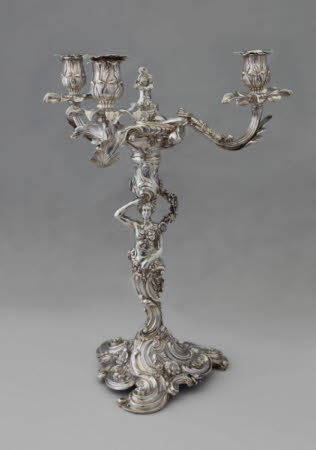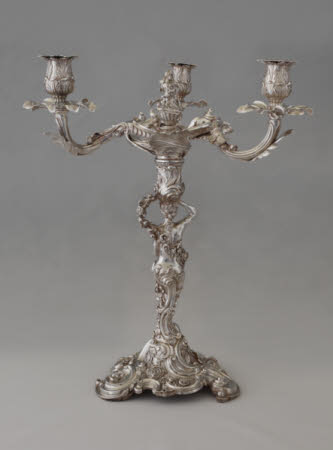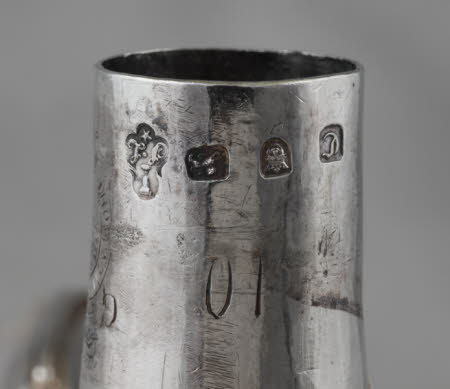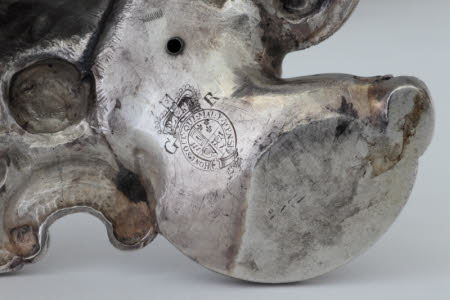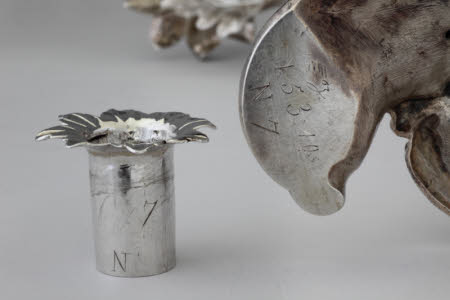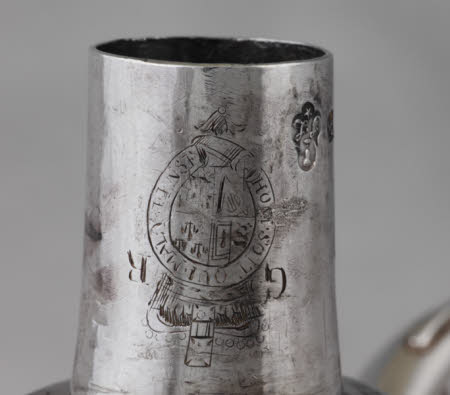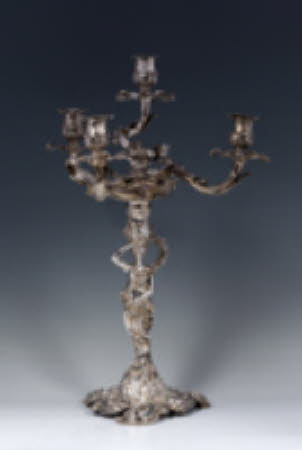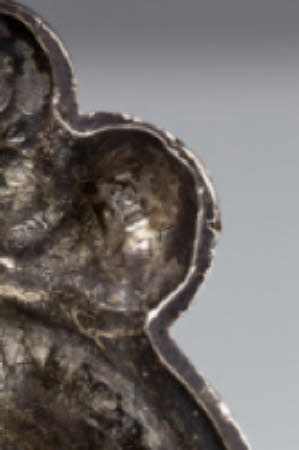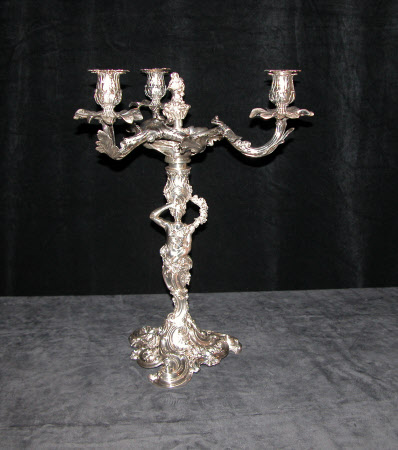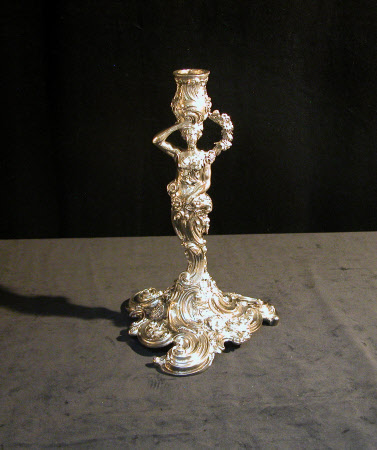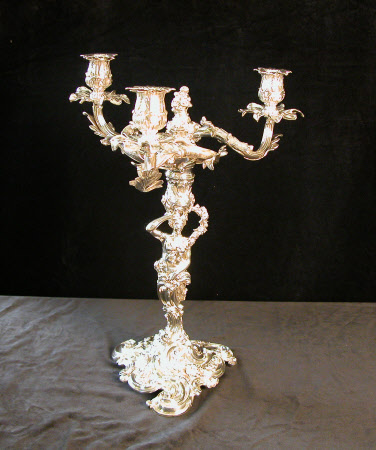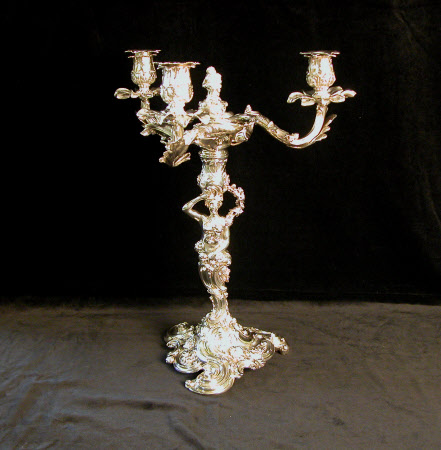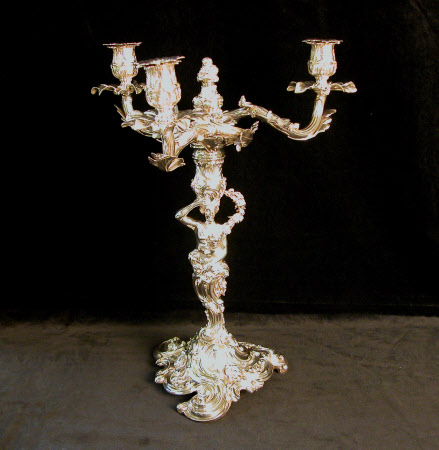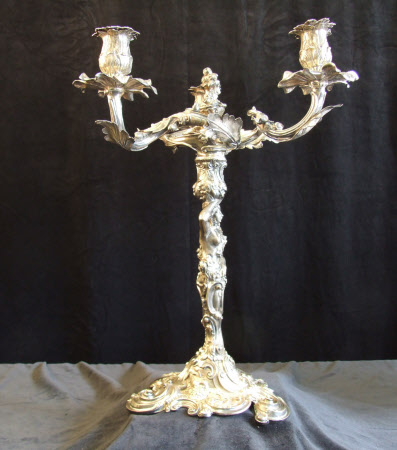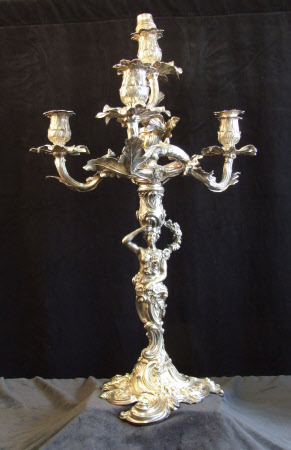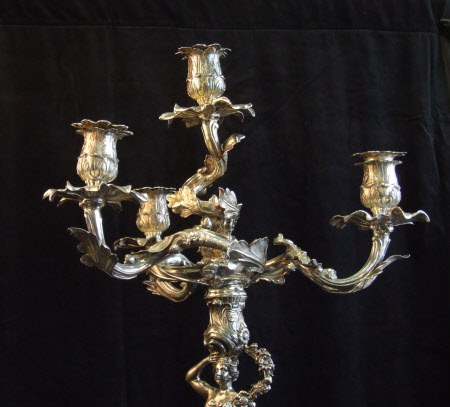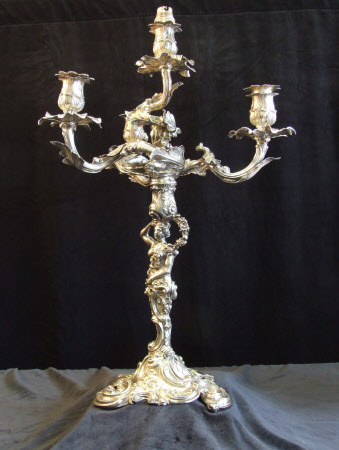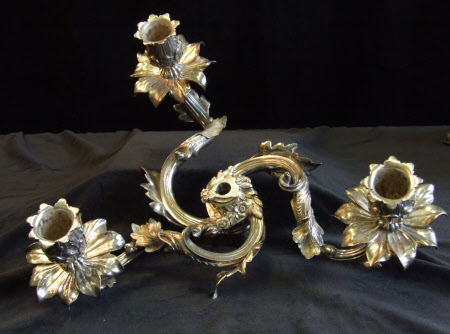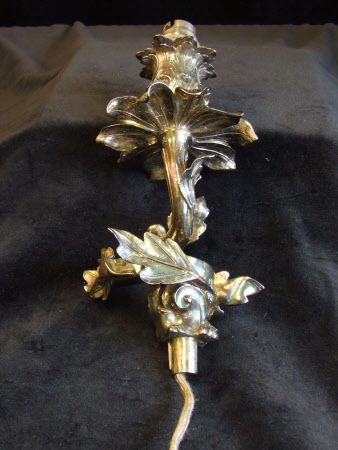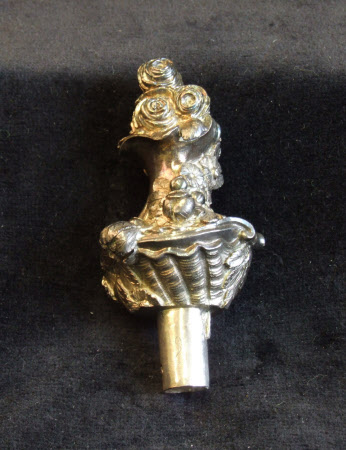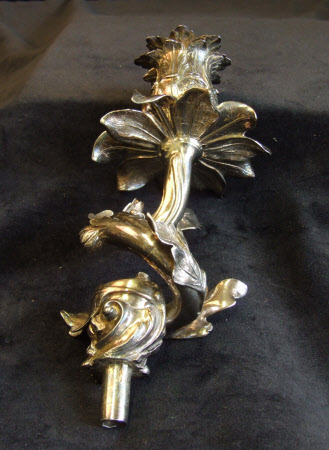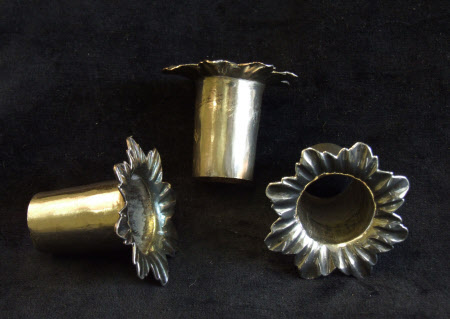Twelve candlesticks with four-light branches
Simon Le Sage and James Peltro
Category
Silver
Date
1758 - 1759
Materials
Sterling silver
Measurements
57.8 cm (Height, with fourth light fitted)
Place of origin
London
Order this imageCollection
Ickworth, Suffolk
NT 852077
Summary
Twelve candlesticks with four-light branches, sterling silver, by Simon Le Sage and James Peltro, London, 1758/9. The candlesticks are cast and chased and consist of irregular triform, domed bases of scrolls and flowers with stems formed as female terms rising out of further scrolls and entwined in floral swags. Each term holds a hand up to a vase-shaped scrollwork and floral socket which is also supported by the continuation of the floral swag (in one case missing). The branches fit into the socket and consist of three spiralling and twisting reeded branches embellished with applied cast and chased leaves and terminating in horizontal calyces of further leaves which form the drip pans. Above are foliate, vase-shaped sockets, the leaves bent over at the top to form a serrated, horizontal lip and the seamed, open-bottomed nozzles having rims shaped to conform. An additional, central socket can either be fitted with a shell and flower finial (one missing when the collection came to the NT in 1956) or with an additional arm which spirals well above the other three and has the same form of socket and nozzle. All of the fourth arms have been drilled for electricity and one stick (no. 3) has had a bolt applied to hold the stick and branches together with the finial in place. Heraldry: On the underside of each candlestick and on the pintle of the branches (except no. 3 which has been altered) are engraved the quartered arms of the Hanoverian monarchs (pre-1801) within the Garter and beneath an imperial crown flanked by the initials G R. Hallmarks: All the branches except those of no. 3, which have been altered, are fully marked on their pintles with the date letter ‘C’, leopard’s head, lion passant and maker’s mark ‘S∙L’ in italics, cup above and mullet below (Arthur Grimwade, London Goldsmiths 1697-1837, London 1990, no. 2576) for Simon Le Sage. The candlesticks are all marked on their undersides. Nos. 6, 7 and 9–12 have the same marks as the branches as do no. 1, except for the lion passant, and no. 5, except for the lion passant and leopard’s head. No. 2 is fully marked but Le Sage’s punch has been struck twice, once over another’s. No. 8 also has Le Sage’s mark and another struck out plus the lion passant and leopard’s head but no date letter. Nos. 3 and 4 are fully marked and struck with both Le Sage’s mark and maker’s mark ‘IP’ beneath a pellet (Grimwade 1990, no. 1575) for James Peltro. All the finials except nos. 1, 2 & 5 are marked with the sterling lion. Scratchweights: On the underside of the candlesticks: ‘1 oz [/] 147 [/] No 1’; ‘2 oz [/] 145 [/]No 2’; ‘3 [/] 147oz [/]No 3’; ‘4 [/] 146 oz [/] No 4’; ‘5 oz [/] 149 ∙ 5 [/]No 5’; ‘6 [/] 148 [/] No 6’; ‘oz [/]153 ∙ 10 [/] N 7’; ‘oz [/] 151 ′ 15 [/] No 8’; ‘9 [/] 154 [/] No. 8’; ‘156oz 10 [/] No 10’; ‘oz [/] 159 10 [/] N ′ 11’; ‘153 oz [/] Nº 12’. All the component parts, including the nozzles, are scratched with the number of the candlestick to which they belong, either with arabic or roman numerals. Not all the parts are still with the correct sticks.
Full description
The sources and evolution of this most rococo of candlestick forms have been carefully analysed by a number of writers in recent years, most notably by Timothy Schroder in his catalogue of the Ashmolean collection.[1] There was a vogue for figural candlesticks in the mid to late seventeenth century [2] and Meissonier and Thomas Germain brought them into high fashion again in Paris around 1730. It may have been in Paul de Lamerie’s workshop that the form evolved successfully in London and he produced a set of candlesticks with bearded terms in 1746, the swirling triform bases of which are close to those of the Ickworth sticks. From two years later are his paired male and female terms now in the Ashmolean Museum and the Virginia Museum of Fine Arts.[3] More of the same form were produced in 1752 (the year after de Lamerie’s death) , this time struck with the marks of Frederick Kandler (Ashmolean Museum) [4] and Robert Tyrill (Museum of Fine Arts, Houston).[5] Schroder’s careful comparison shows that the Kandler set appears to be from the same moulds and to have been chased by the same sophisticated hand as those by de Lamerie. The Ickworth set are extremely close in form to the female term of the de Lamerie/Kandler group though with subtle differences in the chased detail. The flower types are not in the same arrangement, the term’s hair is more pronouncedly knotted at the back, there are marginal variations in the finishing of the scrolls and the base is slightly less flat to the ground. Most notably of all there is, in addition to the garland of flowers passing behind the term’s back, a spray also extending over her chest, presumably for reasons of modesty. Nevertheless the overall conformation and scale [6] are close enough to be from the same moulds, or at least to have been created by someone who had an intimate knowledge of the earlier pieces. Although all the Ickworth sticks bear the mark of Simon Le Sage, who presumably dealt with the bulk of the order rather than Kandler because of his position as Subordinate Goldsmith to the King, two (nos. 3 and 4) have also been punched by James Peltro and on others there is evidence of his mark being defaced or overstruck by Le Sage (nos. 2 and 8). Thus the sticks were almost certainly made by Peltro, or in his workshop, and supplied to Le Sage who was, fortunately, not wholly successful in his attempts to eliminate the evidence, the marks being extremely difficult to detect amongst the wildly contoured and roughly textured surfaces of the undersides. Could Peltro be the link, therefore, between the various groups of this model of candlestick produced during the 1750s? His mark is rarely found, perhaps because he was not a retailer and was exclusively supplying to others, but it does occur on the epergne and stand supplied to the future 1st Lord Scarsdale of Kedleston in 1755 by Thomas Harache (NT 108946).[7] This is a tour de force of chasing in high-rococo style, like the Ickworth sticks, and Peltro’s strong connection with such high-quality workmanship is further shown by a set of four candlesticks of another rococo pattern, marked for 1753, which were sold at Bonham’s, London, on 24 March 2005 (lot 69).[8] There is no consistent form of branches associated with the various versions of these candlesticks but Lord Bristol’s are undoubtedly the most magnificent, with their provision for up to four candles and their swirling, twisting form, embellished by leaves and with foliate sockets which complement but do not match those of the sticks. There is something in them of the intertwined branches of Thomas Germain’s double satyr candelabra of 1732 [9] and the Earl may have seen comparable examples in Turin given that Andrea Boucheron had trained with the Parisian master. Germain famously points to one of the candelabra in his portrait by Nicolas de Largillière (Museu Calouste Gulbenkian, Lisbon) and when Boucheron came to be portrayed he had himself depicted (Palazzo Madama, Turin) holding a drawing of something very similar with the actual candelabrum in pride of place behind him. He could even have been involved with the design or manufacture of the satyr candelabra, having returned to Paris in 1728–9.[10] The Ickworth candelabra are probably the earliest set of such a quality and quantity to survive intact, even down to all forty-eight of the nozzles. They can scarcely have been equalled at the time of their manufacture either, the Wickes ledgers only showing one larger set [11] in the mid eighteenth century and very few others at all beyond the odd pair, such as those copying Germain’s supplied to the future 1st Duke of Leinster in 1745.[12] Similarly, amongst allocations of perquisite plate from the Jewel Office the only grant coming close was that of twelve wrought candelabra received by Sir Charles Hanbury-Williams in 1756 as ambassador to Russia, but those had just two branches each.[13] The Jewel Office allowed only 8s per ounce [14] for Lord Bristol’s candelabra when in reality they are likely to have cost only slightly less than the Leinster pair which were charged at 16s 2d.[15] If taken at 15s 10d per ounce the cost would have amounted to the enormous sum of £1,435 of which the Earl would have had to pay about £710. His bank account [16] reveals only one payment to Le Sage, of £100 on 16 September 1758 via Lady Hervey, and that was a down payment insisted upon by the goldsmith,[17] probably largely allocated subsequently to a set of soup plates (NT 852125). Lord Bristol could have met the remainder by turning in further old plate but that must have been becoming thin on the ground and it is more likely that some of the items presented to the Jewel Office by Le Sage were not actually to be taken delivery of by the Earl. That could explain why the allocation included four dozen plates, which Lord Bristol could not possibly have wanted on top of the ten dozen he already had. There is no evidence of them ever having formed part of the Bristol silver and the same goes for the twelve each of oval and round dishes plus the eight salad dishes. All in all, the Jewel Office paid Le Sage £709 12s 11d for these items which is, very neatly, more or less what was required. Equally neat is the fact that they are the first four items for Lord Bristol listed in the delivery book.[18] Though some of these candelabra have for many years now, and perhaps since the 1820s, bedecked the great dining room table at Ickworth for which they are perfectly scaled they were not intended for such use. Dinner was still eaten in daylight hours and even at supper candelabra, especially Lord Bristol’s with their profusion of branches, would not have mixed practicably with the need to change the dense array of dishes as the meal progressed. Michel-Barthélemy Ollivier’s depiction of a supper given by the Prince de Conti at the Temple in 1766 (Musée national des chateaux de Versailles et de Trianon) shows individual sticks in use, and Lord Bristol already had a substantial provision of those (NT 852104). Instead the candelabra would have been for a great entertaining room – a saloon or a gallery – where they would have been placed on torchères, side tables or brackets for use during evening entertainments. An excellent example is provided by Dunham Massey in Cheshire where in 1758 the Great Gallery had four three-branch silver candlesticks on gilt brackets, as well as fourteen silver sconces and a magnificent pair of six-branch chandeliers.[19] In total this allowed for thirty-eight candles in one room, which was prodigious enough, but Lord Bristol would have been able to muster an additional ten from the Le Sage/Peltro candelabra alone. This may seem wildly extravagant, but he was taking over the vast Monteleone Palace in Madrid from his predecessor, Sir Benjamin Keene, and having been sent plans he knew that the rooms were of gargantuan proportions.[20] In addition, as Ambassador Extraordinary and Plenipotentiary it was expected of him to put on a show of magnificence and he was clearly very ready to do so. A candlestick bearing only the maker’s mark ‘TH’, possibly that of Thomas Holland, is identical in detail to the Ickworth sticks and was probably cast from a mould taken from one of them by Rundell, Bridge and Rundell in the early nineteenth century, whilst overhauling the Bristol plate.[21] Holland would be a good candidate as he was responsible for producing copies of a pair of Emick Romer candlesticks in 1809 for the future 1st Marquess (NT 852093). James Rothwell, Decorative Arts Curator June 2021 [Adapted from James Rothwell, Silver for Entertaining: The Ickworth Collection, London 2017, cat. 72, pp. 156-60] Notes: [1] Timothy Schroder, British and Continental Gold and Silver in the Ashmolean Museum, Oxford 2009, cat. nos. 185-6, pp. 476-485. [2] Most pertinent amongst examples from this period are those with female standing figures holding an arm up to support the sockets above their heads. See a pair marked for Augsburg, 1650, sold at Sotheby’s, 11 February 1999, lot 46. [3] John Culme, English Silver: The Jerome and Rita Gans Collection, Richmond, Virginia 1999, cat. 2, pp. 36-41. [4] Schroder 2009 (see note 1), cat. 186, pp. 482-4; two pairs of male and female terms. [5] Museum of Fine Arts, Houston, nos. 2001.582-7 and 2001.620-1. [6] The Ashmolean group have a height range of 30.6 to 31.8 cm and the pair in the Virginia Museum of Fine Arts are 32.7 cm high. The Houston group are 32.1 cm high. [7] See John Cornforth, ‘A splendid untiy of arts’, Country Life, vol. 190 (13 June 1996), p. 129, fig. 4. [8] Also of 1753 and finely chased, though of a simpler rococo design, are two candlesticks by him which were with S. J. Phillips in December 2015, ref. 41604. [9] Detroit Institute of Arts, acc. no. 56.85.1. [10] Gianfranco Fina & Luca Mana, Argenti Sabauda del XVIII Secolo, 2012, p. 223. [11] National Art Library (henceforth NAL), Garrard Ledgers, VAM 3 1747–50, f. 2, account of Mr. Chase: ‘Nine pr [18] candlesticks & nozils & branches’ weighing 1143 oz 14 dwt. They must have been quite simple as only 3s per ounce was charged for fashion. [12] Ibid, VAM 2 1740–8, f. 146, account of the Earl of Kildare. Another pair of the satyr form, by John Le Sage, 1744, were sold Christie’s, 24 October 1990, lot 247. [13] The National Archives (henceforth TNA), LC 9/45, Jewel Office Delivery Book 1732–93, f. 146. [14] TNA, LC 9/48, Plate Book 1728–1767, f. 168. [15] NAL, Garrard Ledgers, VAM 2 1740–8, f. 146. [16] Barclays Group Archives, Goslings Ledgers, 130/27, f. 65. [17] TNA, NA SP 94/252 Spain, supplementary 1755–60, letter from the Earl of Bristol to Joseph Richardson, 27 November 1758. [18] Jewel Office Delivery Book 1732–93 (see note 13), f. 165. [19] James Lomax and James Rothwell, Country House Silver from Dunham Massey, London 2006, p. 19. Another example is provided by Temple Newsam where there were French plated candelabra for the eight giltwood torcheres of 1745-6 by James and Anne Pascall. Information from James Lomax. [20] Suffolk Record Office, HA 507/7/6, Letters from Secretaries of State to the 2nd Earl of Bristol 1759-61, ff. 449-50. [21] Sold Sotheby’s, 14 March 1996, lot 82. The mark is described as having a pellet between the letters so it may not be Holland’s. The candlestick bears the arms of the 1st Duke of Buckingham and Chandos. Exhibited: Treasures from National Trust Houses, Christie’s, London, 1957–8, cat. 178; Society of the Four Arts, Palm Beach, Florida, 1959 (two); Ideal Home Exhibition, London, 1960 (one); British Week, Milan and Frankfurt, 1965 (six); Silver from National Trust Houses, Treasurer’s House, York Festival, 1969 (two), cat. 37; Treasures from Country Houses of the National Trust and National Trust for Scotland, Europalia 1973, Brussels (two), cat. 121; The Treasure Houses of Britain, National Gallery of Art, Washington, 1985–6 (one), cat. 453.
Provenance
Jewel Office; allocated to George Hervey, 2nd Earl of Bristol (1721-75) as Ambassador to Madrid 1758; discharged to Lord Bristol 9 April 1759; by descent to the 4th Marquess of Bristol (1863-1951); accepted by the Treasury in lieu of death duties in 1956 and transferred to the National Trust in 1983.
Credit line
Ickworth, the Bristol Collection (National Trust)
Marks and inscriptions
Engraved with arms of George II.
Makers and roles
Simon Le Sage and James Peltro, goldsmiths Simon Le Sage, goldsmith James Peltro, goldsmith
